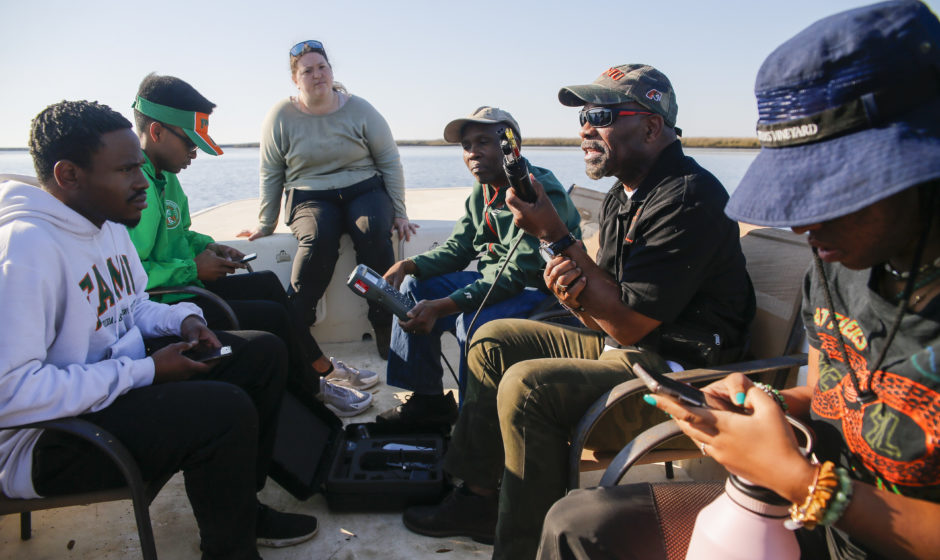FAMU School of the Environment Rattler Moji Buoy Provides Real Time Data of Water Conditions in Apalachee Bay

SPRING CREEK, Fla. – A team of Florida A&M University (FAMU) School of the Environment faculty, staff and students boarded a 24-foot Carolina skiff at Spring Creek marina in Wakulla County, on Friday morning.
The team was headed out to Apalachee Bay to perform maintenance on the Rattler Moji, a solar-powered water sensing buoy that monitors water quality around the clock. Data from the buoy is beamed around the clock to the School of the Environment’s Core Lab and is accessible to researchers and students on their cell phones in real time.
Dean Victor Ibeanusi, Ph.D., said the buoy, which measures key water quality parameters – salinity, conductivity, pH, temperature, nitrate and algae levels, is a vital coastal marine research tool.
“The best way to determine the impact of climate change is checking water quality,” he said. “Water quality is the nexus between energy and food production. We conduct research so we can provide sustainable solutions.”

Climate change continues to impact these coastal communities requiring research that monitors the water quality of these coastal requiems, especially here at the Gulf Coast. FAMU is home to the National Oceanic and Atmospheric Administration (NOAA) funded Center for Marine and Coastal Systems. Aquaculture is critical to resolving the world’s food insecurity and projected future food shortages.
The recent excursion was to clean barnacles from the base of the Rattler Moji and replace one of the measuring probes. To get to Apalachee Bay, the skiff motored through Spring Creek, the world’s largest spring head, which produces 1.2 billion gallons of water daily. At the helm was Rob Olin, owner of Estuary Oysters, who partners with the School of the Environment. The buoy floats in waist deep water within a stone’s throw of the floating cages that are part of Olin’s 7.5-acre oyster ranch in Apalachee Bay.

Oysters need brackish water – a certain mixture of salt water and fresh water – to thrive. Too much fresh water or too much saltwater kills the popular shellfish.
“We lost 80 percent of our crop last September because of too much fresh water,” Olin said. Fortunately, Rattler Moji had been installed shortly before. “Thank God for this buoy because it measured the salinity level which I was able to take back to the federal farm agency for crop insurance.”
“Because of your research and our partnership,” Olin told Ibeanusi and the students, “we’ve been able to better educate the farm agency about what they need to cover and why regarding this new industry.”
Apalachicola Bay, once home to one of the most lucrative seafood industries in America, has been closed to traditional oyster harvesting. Olin and other oyster ranchers are part of a fledgling aquaculture industry that grows oysters from seeds and sells mature oysters to restaurants and kitchen tables. The partnership with Estuary Oysters allows Dean Ibeanusi and faculty members to help FAMU students to see the connection between what they learn in the classroom and what happens outdoors.
Jordan Roberts, a graduating senior environmental science student from Tallahassee, was part of the team that launched the buoy last September.
“Six months later, the buoy is still thriving, still standing and then we have students now able to be hands on, help us clean it and to just ensure that data just keeps coming in real time,” said Roberts, who thinks more students would get excited about the environment if they had these kinds of opportunities to treat the outdoors like a classroom.
“This is something that students would definitely be really excited about as it pertains to environmental science because it’s hands on; it’s fun; you get to go out on the water; you get to experience oysters; you can get experiences with wildlife in real time.”



